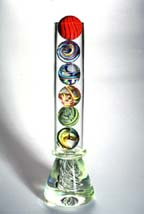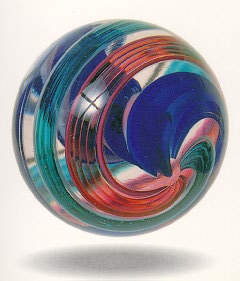
|


|

|
|
Eileen's Marbles
| |
|
|
When you hold a marble in your hand, you hold a piece of history.
-- Marilyn Barrett
| |
| |
|
Three things I'm going to discuss on this page about marbles are the games, some history and the marbles themselves. Although there were few children in my youth with which to play marbles, I did manage to find a few to play with. The locality in which I grew up did not present good outdoor game possiblities as it is damp most of the year and it is very hard to find ground level enough to play. The area was also rural with few children interested in the game. The typical game we played was an indoor/outdoor circle game similar to "Ringer."
The game was taught to me by my father when I was barely old enough to play with marbles. He probably wasn't really sure of the rules then. When I was older I asked him what they were because I finally had some neighbors interested in "Marbles." He said that he could not remember them. Just that it was with a circle drawn on the ground or smooth surface, and that you shot the marbles out of the circle. I did remember how to "knuckle down" with my boulders, so I was pretty good against my new opponents. We always played "for fair" because they were never as good as I was, and I was a lot older.
The following outline is adapted from a recent speech I made on marbles while I had my collection on display at the Longview Public Library in Longview, Washington. Follow the links for more detail on the subject of marbles. For explanation of some of the terms, visit my
Glossary.
|
Marble History
- Archeaologists have found marbles in ancient sites.
- Small clay balls were found in the tombs of Egyptian kings.
- It is believed that the Aztecs played a form of marbles.
- Clay balls have been found in the southwestern U.S. in prehistoric pueblo ruins.
- More history...
|

Photo credit: Michael Love, http://www.netglass.com/artists/beetem/ |

|
Marble Games
- There are many marbles games.
- There are chase games.
- There are hole games.
- There are circle games.
- Marbles have been the basis of other games.
|
Marble Types
Identification of marbles:
- There are many types of marbles.
- Antique marbles were made by hand.
- Hand-cut, hand-polished stone marbles.
- Hand-rolled, glazed or painted, clay and china marbles.
- Hand-blown glass marbles.
- Machine-age brought machine-made marbles around the turn of the 20th century.
- James Leighton developed a pair of tongs for handmade marbles.
- The Golden Age of marbles occurred during the late 1920s and the 1930s.
- Cat's Eyes from Japan introduced.
- Today's marbles are modern versions of early marbles and the early machine-made marbles.
|

|
|
|
There are four basic sizes found in marbles -- those called carpet balls or mongos, shooters or boulders, players or "commies," and "peewees." Modern machine-made marbles mimic the antique marbles of the Golden Age and contemporary hand-made marbles resemble other worlds, aquariums and other early handmade marbles.
Marbles have been used for playing games; marbles has a long history as a children's game; and many people today collect marbles.
|
|
|
The allure of marbles is timeless and universal,
spanning, culture, generation, language, and class.
-- Marilyn Barrett
| |
|
Afterword from - Fred Ferrettii's The Great American Marble Book
Marbles, we've found, is something to which people remain nostalgically attuned, no matter their age, no matter how far removed in time or distance, and we thank those who took time out to inform us:
- That the late Senator Estes Kefauver once shot marbles on the floor of the Senate, and that Representative Bella Abzug was, and possibly is, great at immies.
- That two automobile workers, desirous of helping small boys shoot big marbles, devised a sort of marble-shooting popgun several years ago which could automate marbles games. Patent number 2,791,210.
- That New York University, its football team a thing of the past, created a marbles team, "The New York Institute for the Investigation of Rolling Spheroids," and issued a blanket challenge to all comers.
- That an Indianapolis woman bought her husband a bag of marbles at an auction for one dollar as a joke, and later found them to be 150 aggies, worth one dallar each.
- That a lad in England, who watched his father "swallow" a marble as a magic feat, tried to duplicate it with 14 successive marbles and became ill.
And, finally, our thanks to Margaret Whiton, who wrote to me about a most important, and often overlooked, aspect of marbles: how they are kept and in what.
"During the period that my son was devoting a lot of time to playing marbles I noticed that he spent almost as much time fondly contemplating his collection. Also it was very important that he have a container worthy of these precious beauties. This is where I came in. He was confident that I could produce a beautiful marbles bag, even though my prowess at the sewing machine had previously limited me to ordinary repair work. I remember his standing over me while under his supervision a lovely green woolen bag with silken braided cord for drawstring came to life. Then I embroidered his initials in orange. For several years this was one of this most treasured possessions."
|
|
| Bibliography |
Photo Credits |
- Barrett, Marilyn. Aggies, Immies, Shooters, and Swirls: The Magical World of Marbles. Little, Brown and Company, 1994.
- Baumann, Paul. Collecting Antique Marbles. De Moines, IA: Wallace-Homestead Co., 1970.
- Ferrettii, Fred. The Great American Marble Book. New York: Workman Publishing Company, 1973.
- Strutt, Joseph. The Sports and Pastimes of the People of England. London. 1898.
|
Marble photos used on this site are of those made by the following contemporary artists and manufacturers offer them for sale over the Internet.
- Jody Fine/J.Fine Glass Company
- Geoffrey Beetem
- Jabo Vitro
- Nadine MacDonald
- Charles Gibson/Gibson Glass
- Cape Cod Glassworks
- Ro Purser
|
|
|
Song: "Peanuts Theme"
|

|


|

Send a Blooming Basket!
|
|
|

|







